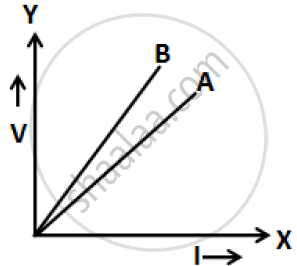Advertisements
Advertisements
प्रश्न
The V-I graph for a series combination and for a parallel combination of two resistors is shown in the figure below. Which of the two A or B. represents the parallel combination? Give reasons for your answer.

उत्तर १
For the same change in I, change in V is less for the straight line A than for the straight line B (i.e. the straight line A is less steeper than B). The straight line A represents small resistance, while the straight line B represents more resistance. The equivalent resistance is less in a parallel combination than in a series combination. So, line A represents a parallel combination.
उत्तर २
‘A’ shows parallel combination because in case of parallel combination, the resistance is less for their potential is less, currents is more.
संबंधित प्रश्न
Complete the following :-
(a)

How will you oonnect five resistors, each of the value one ohm, to obtain an equivalent resistance of 0.2 `Omega`
Name the material of wire used for making standard resistances. Give a reason.
What is a resistance? Define it with respect to Ohm’s law,
In the circuit shown below, calculate the equivalent resistance between the points (i) A and B, (ii) C and D.
Two resistors of 4Ω and 6Ω are connected in parallel to a cell to draw 0.5 A current from the cell.
Draw a labelled circuit diagram showing the above arrangement.
Calculate the quantity of heat that will be produced in a coil of resistance 75 Ω if a current of 2A is passed through it for 2 minutes.
Two resistors having 2Ω and 3Ω resistance are connected—(i) in series, and (ii) in parallel. Find the equivalent resistance in each case.
The resistance of two resistors joined in series is 8Ω and in parallel is 1.5Ω. Find the value of the two resistances.
Two wires of the same length and area made of two materials of resistivity ρ1 and ρ2 are connected in series to a source of potential V. The equivalent resistivity for the same area is:
